Oh Dam! Dam Technology in New Zealand: Part 1
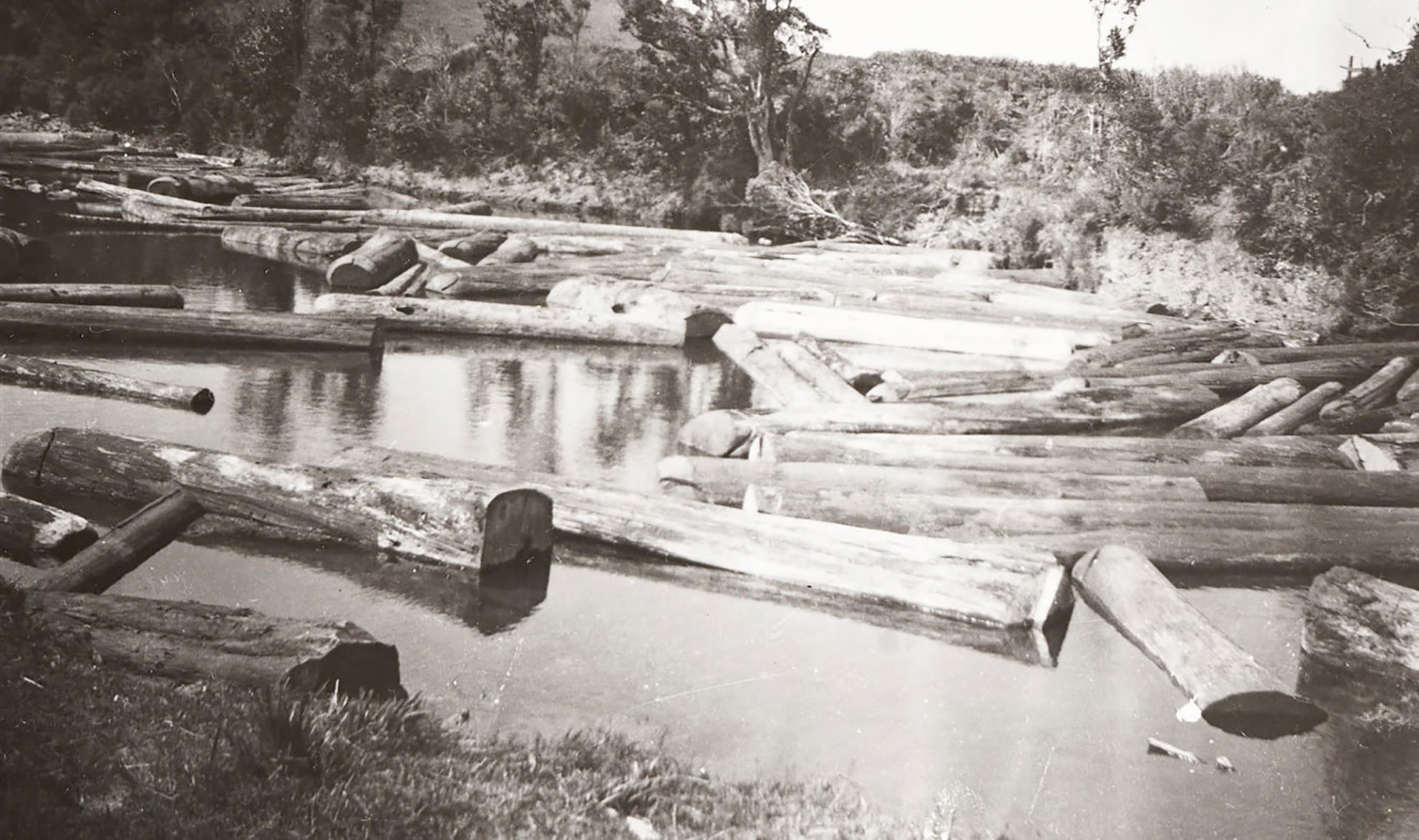
The basic idea behind a dam is pretty simple: find a body of water; construct a barrier to hold back the water — there you go, you have a dam.
Still, this simple concept has produced some complex, important and innovative iterations within New Zealand.
This first of two blogs about dam technology illustrates the beginning of dam building in New Zealand.
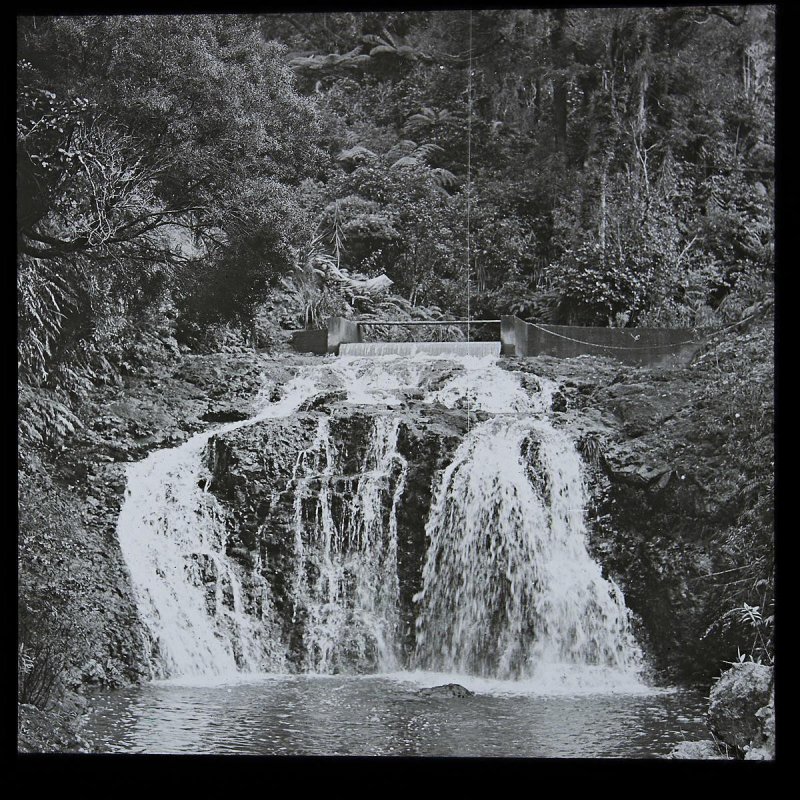
DAMS AND EARLY INDUSTRY
Small, local dams were used in farming, mining and forestry industries early in the colonisation of New Zealand.
With the expansion of these industries during the late 19th century, associated infrastructure like sawmills, railways and dams began to be built.
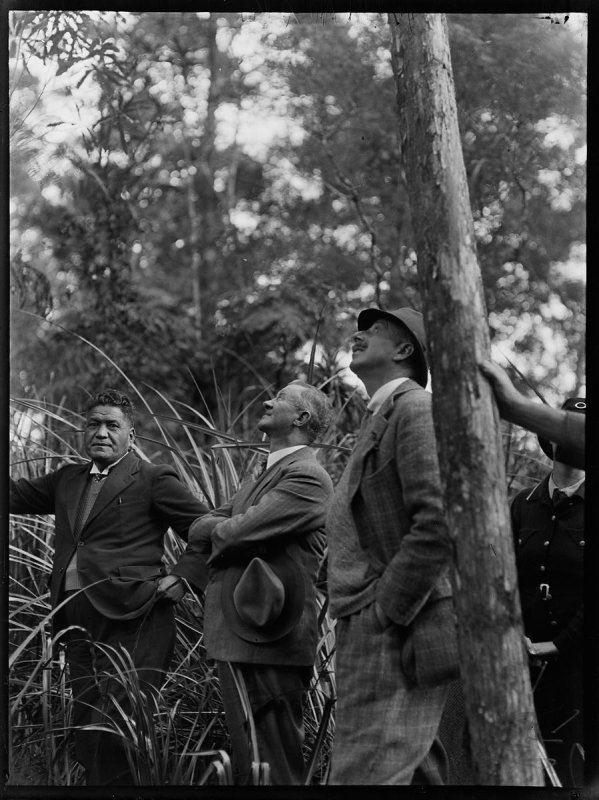
DAMS IN FORESTRY
Forestry became a key industry from the mid-19th century, as the native timber which covered two-thirds of the land was felled for use in house building, ship building and overseas export. It was also linked to creating and innovating dam technology, in a large part due to the kauri industry.
Kauri was one of the most sought after timber species due its large size and straight grain. As it has the additional benefit of being the only native New Zealand timber which floats, bushmen in the Coromandel, Waitakere Ranges and Hokianga built dams in local waterways to help transport kauri logs from where they were felled.
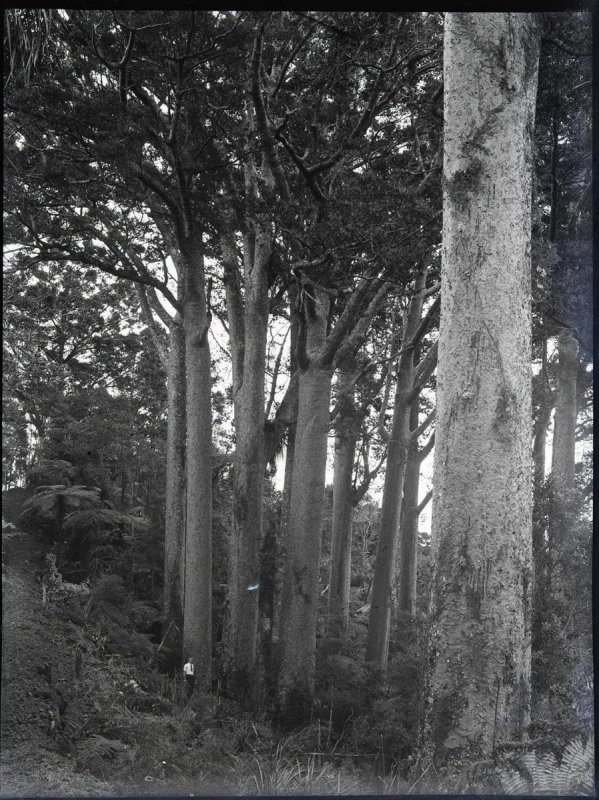
During his time working and living as a kauri bushman, New Zealand photographer Tudor Collins documented the social and technological aspects of the kauri industry in the North Island.
Collins’ image below shows a log drive, where kauri logs were floated from felling areas down river during floods, when water levels were high and fast moving.
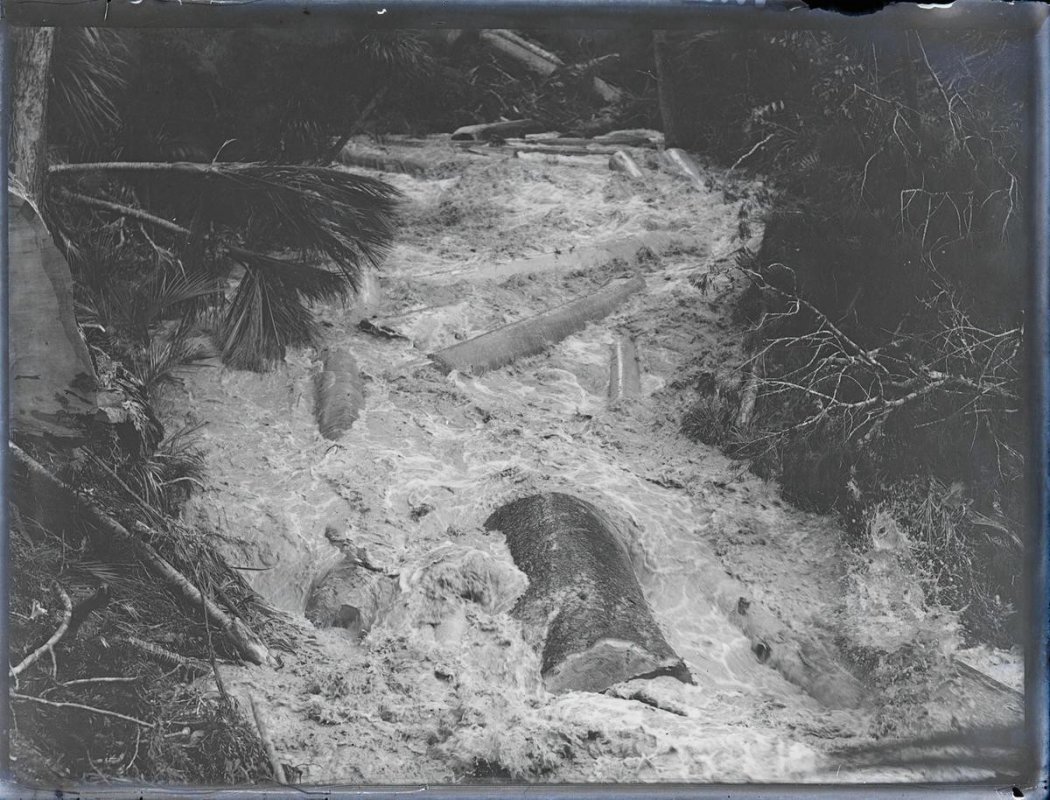
To help augment natural floods, kauri bushmen built wooden dams. Multiple dams would be constructed in streams and rivers, storing water for synchronised release during floods to transport the logs. Dams released larger amounts of water than natural floods, which increased the number of logs transported during the drives.
Logs ended up in natural inlets or areas of more navigable water where a floating structure made of wooden booms collected them. The image below taken by Tudor Collins shows logs in one such area in the Coromandel, circa 1910s-30s.
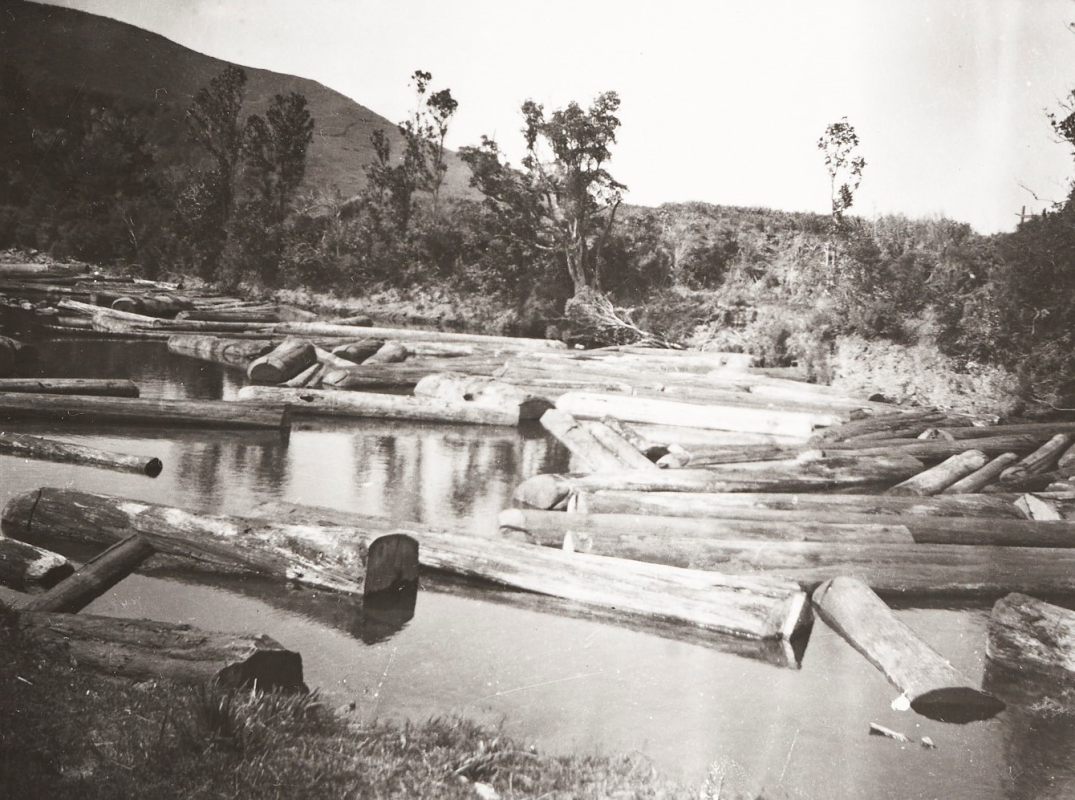
Over the course of the kauri industry, an estimated 3,000 log dams were constructed in New Zealand. The builders of these dams were talented engineers, whose designs tailored technology to New Zealand conditions by incorporating innovative developments, such as a lifting gate design that allowed for easy release of the water and logs.
The dams themselves were regarded as impressive engineering feats. Built without detailed calculations, they were able to withstand tonnes of pressure from water and the kauri logs which went through them with tremendous force when the dams were tripped.
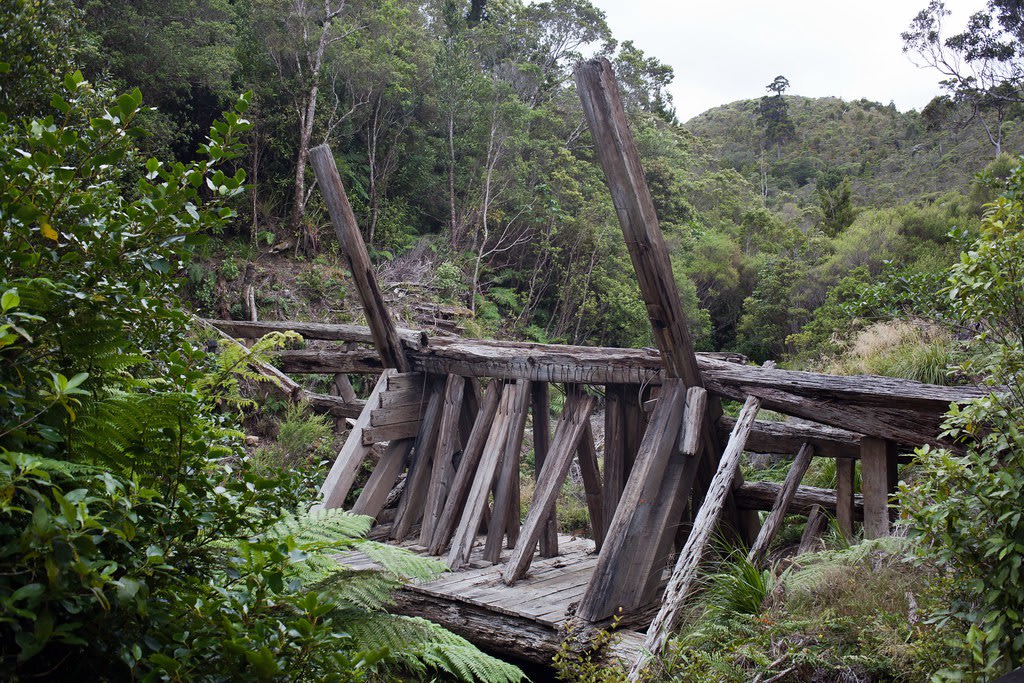
Although efficient, dams and log drives destroyed an estimated 30–40% of logs as they barreled down rivers. As a result, bush tramways and steam haulers were developed to replace drives in the later years of the kauri industry.
![Tudor Collins. 1918–1930s. [Print of Kauri tramway and huts in bush]](https://images.ctfassets.net/mplktqcfflsk/CsEKj69uRfvJg3BQRKCZB/135b7edd7405e19b1a0058833afa8cdc/1_Pqfpp8aCGcK5w1-R8bUaKA.png?w=630&h=800&q=85&fm=png&bg=transparent)
By the early 1900s, so many kauri trees had been felled that the species was at risk of extinction. To ease the pressure on the species, the focus for forestry moved to planting and milling exotic timber.
With this change, the kauri industry came to a standstill, but many of the timber dams were left in situ. A number of these structures are still there in native bush and have become sites to visit on popular walks.
WATER PROVIDERS
Auckland is currently experiencing its worst drought in 25 years, with water storage levels sitting below 50%. This drought has arisen because of an unusually hot summer combined with low rainfall, especially in the Waitākere and Hunua Ranges, where nine dams constructed between the 1910s-70s hold the majority of Auckland’s water supply.
CHANGING WATERS
Before construction of the Waitākere and Hunua dams, Auckland’s water supply was provided by ground water from lakes, such as at Western Springs.
Western Springs was one of Auckland’s first water providers, with MOTAT’s Pumphouse pumping the water from the Springs into Ponsonby and Karangahape Road reservoirs. Visitors to MOTAT can see the restored Pumphouse.
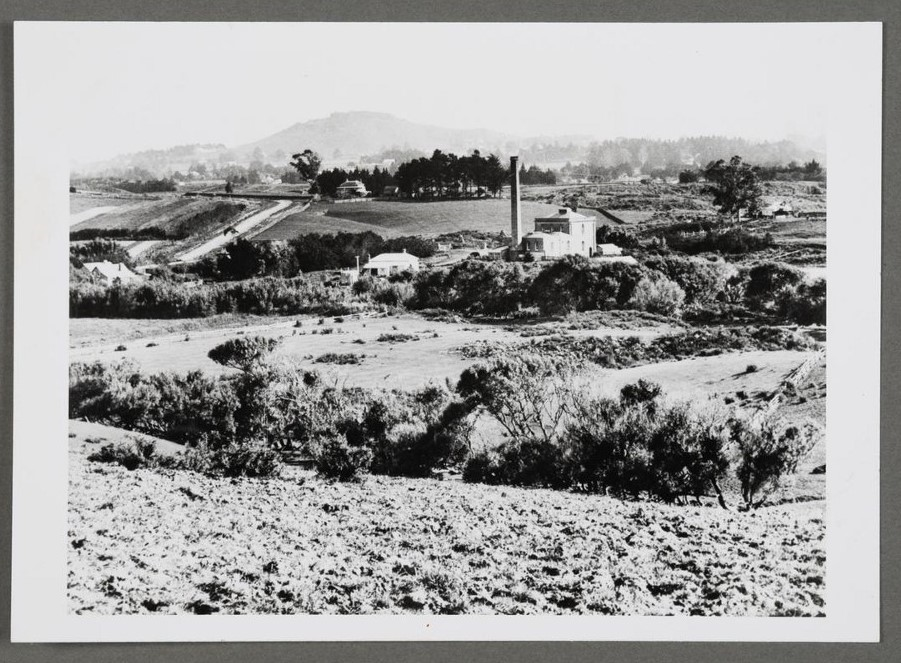
By using water from groundwater sources, quality could be better controlled and the water distributed further. As Auckland’s population rapidly grew, however, these sources were becoming exhausted so Auckland City Council explored opportunities for other supply areas:
Engineers looked to the hills around Auckland for future water sources and the first Waitākere Dam was constructed in 1907 that exists today and is in supply as we speak. — Watercare headworks manager, Joseph Chaloner-Warman, RNZ interview
With their high elevation and rainfall, the Waitākere Ranges were the first area scoped out for the construction of 5 dams which aimed to to supply 65% of water to Auckland.
WAITAKERE DAMS
The first to be built was the Waitākere Dam. Completed in 1910, this dam is located high in the ranges and fed by rainfall and inlets from streams and tributaries. It is built from concrete and relies on gravity from its high location in the Waitākere Ranges to treatment plants at a lower altitude, then on to consumers.
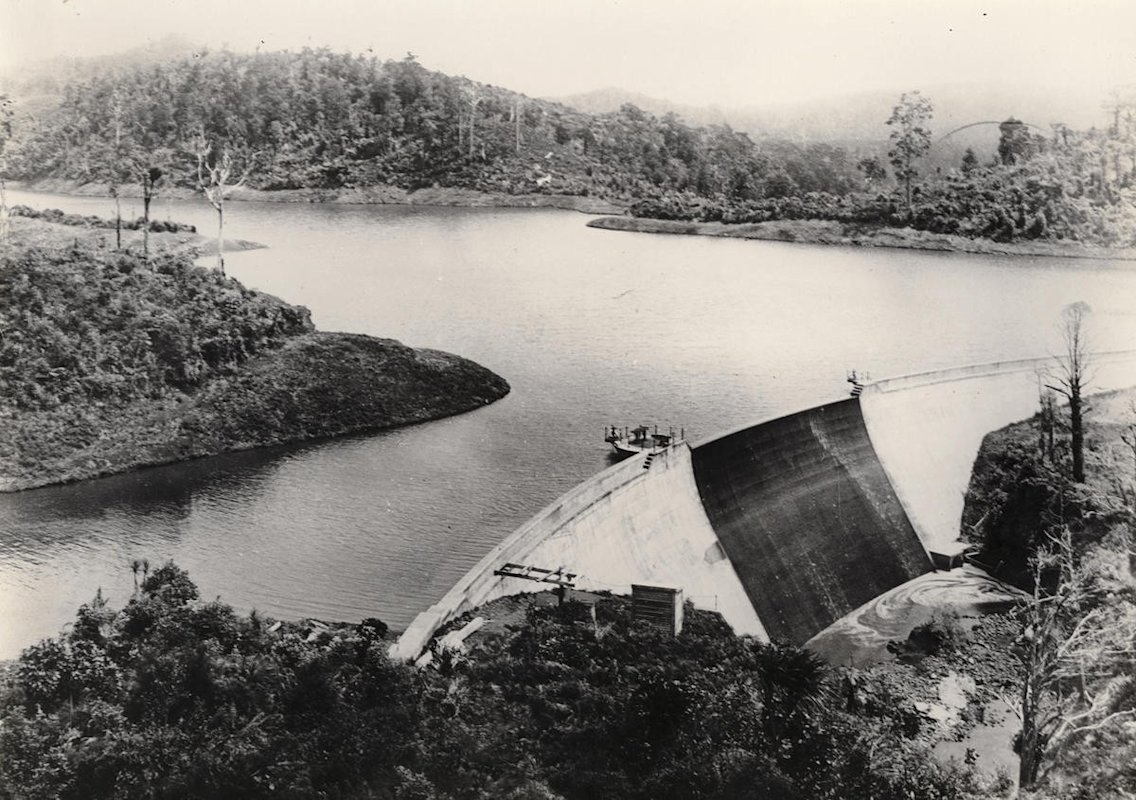
The type is known as a concrete gravitational dam, and two more dams were constructed in this style in the Waitākere Ranges in the 1920s. These are the Upper Nihotupu Dam completed in 1923, and the Upper Huia Dam finished in 1929.
Tailoring the design and construction of these dams to the Waitākere locations was an extensive project with involvement from many prominent New Zealand engineers. One was Walter Ernest Bush, designer of the Upper Nihotupu dam, whose other engineering works, including roads and municipal buildings, helped shape the landscape of Auckland today.
Associated infrastructure was also needed to get these dams up and running. An example is the rail lines built for transporting material into the bush, and rock crushing machines such as the one seen below.

These dams were among the first large-scale concrete gravitational dams built in New Zealand. As such, the techniques and designs used were informative when other water storage dams were constructed in other places in New Zealand during the 20th century.
UPPER NIHOTUPU DAM
Construction of the Waitākere dams was an expensive, dangerous and lengthy process. This is illustrated in the timeline of the construction of the Upper Nihotupu Dam, which began in 1915 and was completed in 1921.
From the beginning of the project, there were multiple issues including heavy rains, injuries, slippages, deaths on the construction site, and shortages of labour and materials because of World War One. These issues caused multiple delays resulting in little progress for four years.
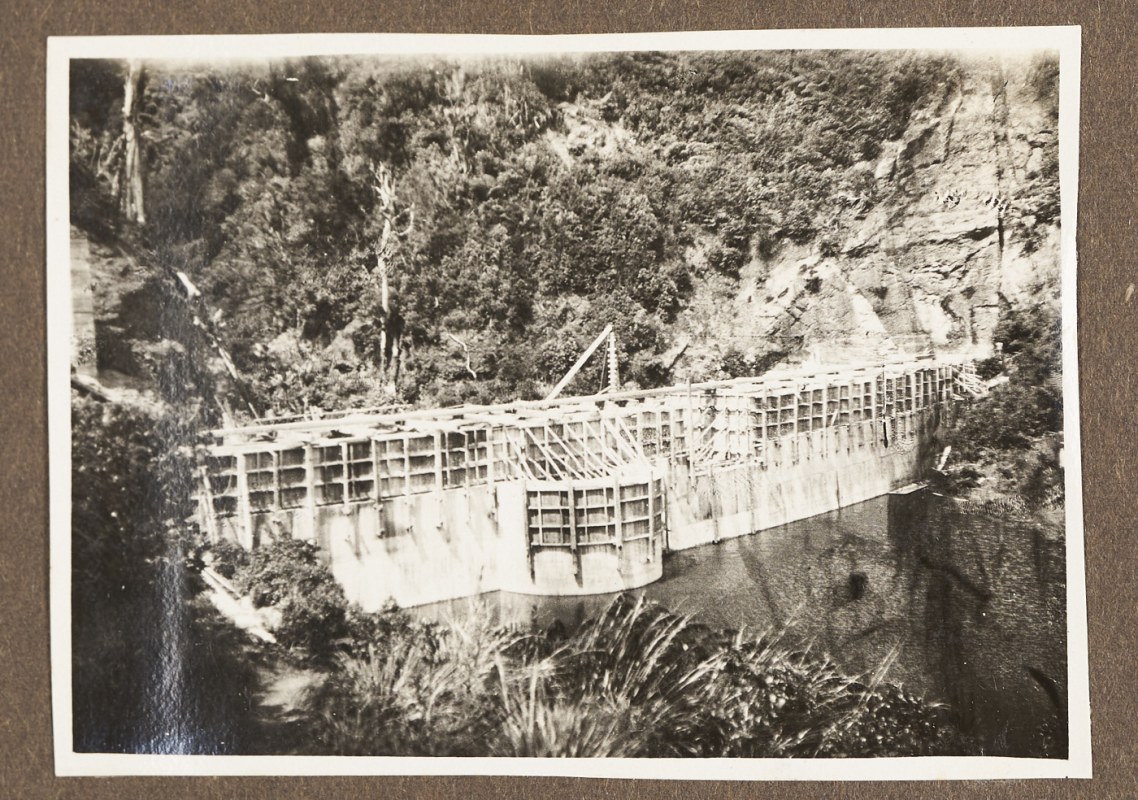
To ease the pressure on the Waitākere dam while Upper Nihotupu was being built, a smaller auxiliary dam was constructed nearby, which opened in 1921 and was still in use until 1987.
Eight years and almost $200,000 after construction began, the Upper Nihotupu Dam was completed. It was officially opened on 14 April 1923 by Hon. Joseph Gordon Coates, Minister of Works. The event is commemorated by an engraved section of a 100-ton electrical cable used in an aerial crane during the building of the dam, seen below.
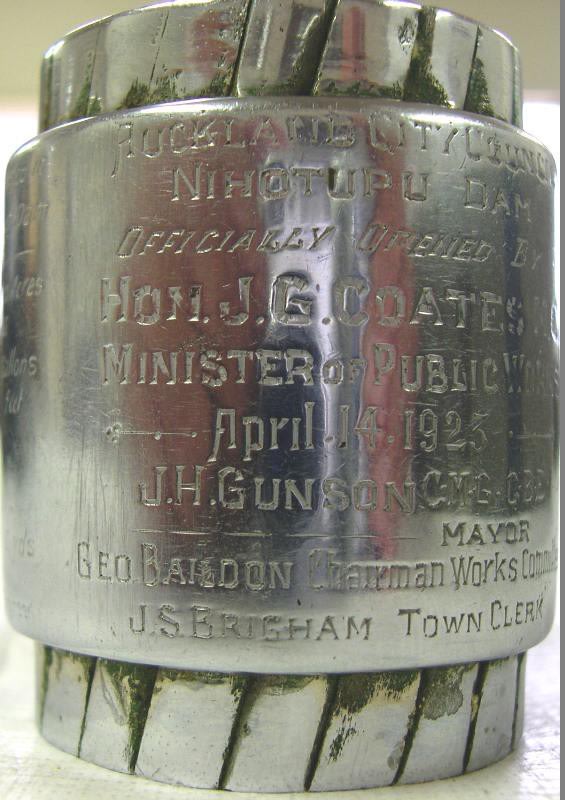
DAM INNOVATION
During a very dry summer in 1942-43, Auckland’s water supply was in crisis. At one point, storage levels was reduced to only a one-day supply, a potential disaster saved only by a bout of exceptionally heavy rain.
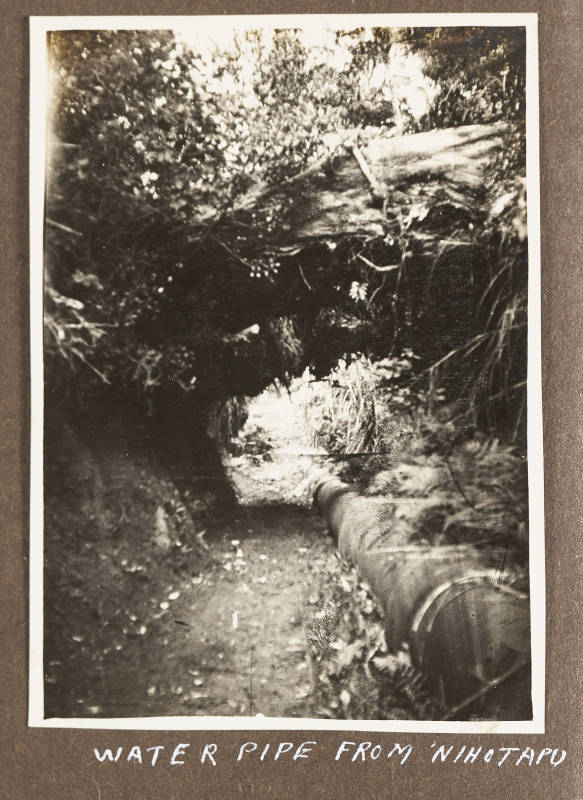
Spurred by this close call, a fourth dam in the Waitākere Ranges was planned. Built on the lower area of the Nihotupu river, this location was first proposed in 1915, but postponed due to World War One and the Great Depression of the 1920s and ‘30s.
Engineering practice had shifted in the meantime, so different techniques and technologies were explored. As a result, Lower Nihotupu is an earth dam made from compacted layers of earth and impervious material (such as rocks, clay) found on the site.
![George Kent Limited. Water Meter [Venturi]](https://images.ctfassets.net/mplktqcfflsk/3lLED8MBRiKqMQhHkKNeUn/a3e17afb4a33df0b79de493c09a94bde/0_VjOsuhDn35oAVALW.jpg?w=553&h=800&fl=progressive&q=85&fm=jpg&bg=transparent)
New Zealander Cyril Firth was a specialist in engineering geology who designed Lower Nihotupu as New Zealand’s first rolled earth dam. It was officially opening on 4 December 1948.
It was described by the Waikato Independent on 29 August 1949:
Although the earth dam has been used to a considerable extent overseas, it is only within recent years that fairly large-scale projects have been attempted in New Zealand. These have been rendered possible, as in other countries, by the availability of modern earth moving and compacting equipment, and the necessary technical knowledge required to select suitable types of soil, handle the… correctly on the job.
Touted as a ‘ground-breaking project’ the construction of the Lower Nihotupu earth dam reflected changes in New Zealand's engineering practice. Soil dynamics and engineering geology began being taught at Auckland University’s School of Engineering and exploratory construction and testing techniques used during construction of Lower Nihotupu paved the way for future earth dams in New Zealand, including a sequence of 5 rolled-earth dams constructed in the Hunua Ranges between 1950-77, and the Lower Huia dam in the Waitākere Ranges, built between 1967-71.
Innovative approaches used in the Hunua and Lower Huia earth dams included the use of imported specialised earth-moving machinery never before used in the country, and consultation with international experts. The design of the Hunua dams was a collaboration between Auckland City Council and the University of Auckland Engineering School and used soil and hydraulic mode testing and analysis which was state-of-the-art for the time.
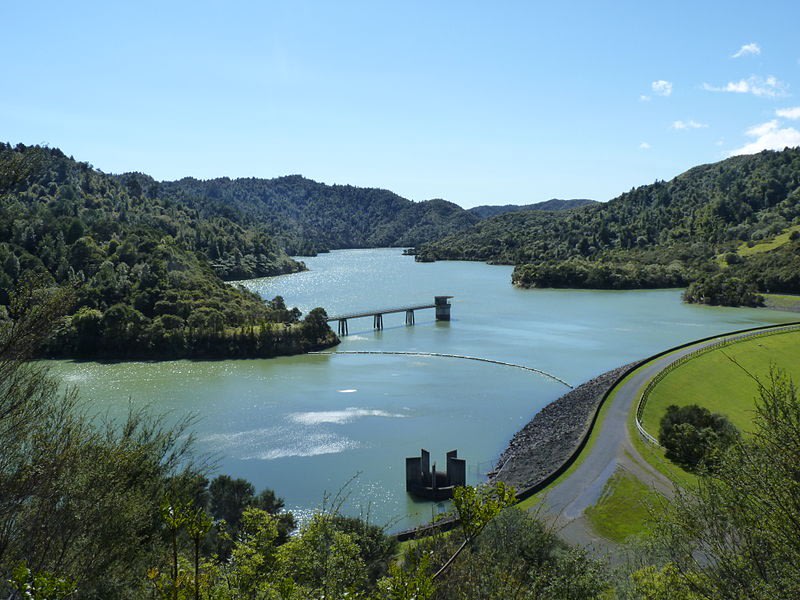
WAITAKERE AND HUNUA DAMS TODAY
All of the nine dams discussed above are still in use today, supplying around 80% of Auckland's drinking water. The supply is supplemented by ground sources, such as the Waikato River.
The combined capacity of these dams is estimated to be around 100 billion litres. This amount seems enormous but Auckland’s current water shortage shows just how easily disrupted this resource is and that the dams can quickly be depleted.
As of 8 June 2020, Auckland’s water supply is sitting at 45.1% capacity, almost 30 percent lower than the average for this time of year. As a result, while Aucklanders wait for winter weather to top up water supplies, Auckland Council has implemented water restrictions to conserve what is left.
To understand these restrictions and how you can help conserve water in your home and work check out the Watercare website.
REFERENCES
Cite this article
Elmer, Freya. Oh Dam! Dam Technology in New Zealand: Part 1. First published: 9 June 2020. URL www.motat.nz/collections-and-stories/stories/oh-dam-dam-technology-in-new-zealand-part-1